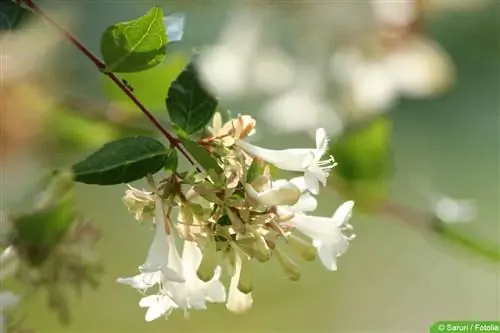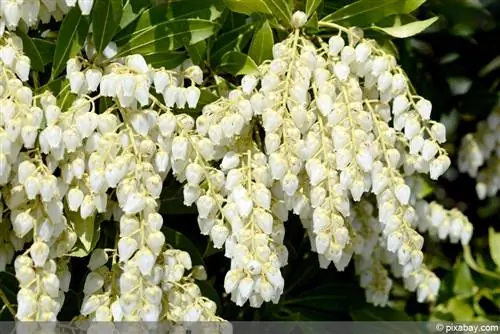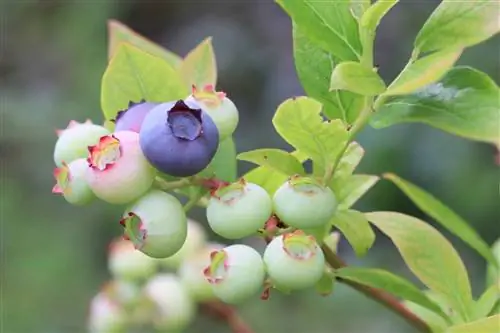- Author admin [email protected].
- Public 2023-12-17 03:39.
- Last modified 2025-01-24 12:45.
The midday gold (Gazania rigens), which originally comes from South Africa, has become very famous in this country because the flowers only open when the sun is high in the midday sun.
Profile about the midday gold
- Growth height: fifteen to twenty-five centimeters
- Growth width: ten to twenty-five centimeters
- Growth habit: bushy
- Leaves: summer green
- Leaf shape: narrow
- Leaf color: green
- Flowering period: May to October
- Flower shape: single flowers
- Flower color: yellow, orange, red, brown or white
- Color combination: single or multi-colored
Location Requirements
Gazanias place very high demands on their location, so this should be carefully considered before planting. The perennial prefers a full sun spot with midday sun in a location protected from rain. Similar to its naturally occurring relatives in South Africa, midday gold thrives best in a sandy to loamy soil substrate that is highly permeable to water and rich in nutrients.
Tip:
In order to loosen up the layers of earth cost-effectively, we recommend incorporating standard sand or gravel from the hardware store.
Planting partner
The Gazania is ideal for planting in beds due to its bushy but compact growth habit. It harmonizes particularly well with equally colorful flowers that particularly love the midday sun, such as marigolds, lobelias or marigolds. However, all plants that have the same location requirements can be used as planting partners.
Note:
The dense growth of the Gazania giant enables container cultivation even in smaller pots, which can be placed on window sills or narrow walls.
Planting
The Gazania is generally not hardy, which is why it must be planted outside of the frost periods. In order to avoid damage caused by late frost, application should take place at the end of May at the earliest. When planting in beds, it is recommended to maintain a distance of fifteen to twenty centimeters between the individual perennials in order to provide sufficient space for growth. The hole dug should be at least twice the current pot size. After filling with the appropriate soil substrate, the plant only needs to be lightly watered.
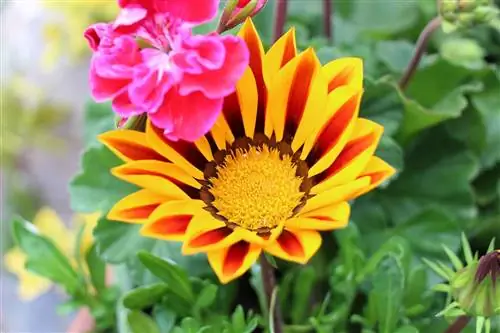
Tip:
In order to promote the growth of the perennial, especially in the area of the roots, it is recommended to add a slow-release fertilizer that also contains a root agent when planting.
Propagation
Gazanias are usually propagated using seeds, which you can either collect from your own flowers or purchase from specialist retailers. Another option for propagation is to take cuttings in late summer. This involves cutting off the corresponding shoots from the mother plant, removing their leaves and planting them in separate pots.
The process for propagation by sowing is as follows:
- Sow seeds in a planter box in February and cover lightly with soil
- Choose a bright, but not sunny, warm and protected location
- Prick out young plants when they are eight to ten centimeters in size
- Planting out after the end of the frost period
Note:
Since the plants available in this country are often not winter-hardy hybrid crosses, they usually produce seeds that are difficult to germinate. If you prefer to grow from seeds, it is a good idea to purchase the seeds from specialist retailers.
Pouring routine
Gazania rigens prefers rather dry soil, so watering should only be moderate. The midday gold reacts particularly to waterlogging with rapidly progressing rotting processes on the roots. It is therefore advisable to distribute the amount of water over several doses per week and to only water the substrate. Moistening the leaves or flowers in a very sunny location will cause irreparable burns.
When cultivating in a bucket, the following additional instructions should also be observed:
- Fit flower pots with a drainage layer of gravel and drainage holes
- Avoid pot coasters or empty them after each watering
- Sampling the substrate around the perennials to determine moisture
Fertilizer rules
Since the midday gold prefers nutrient-rich soil, regular application of fertilizers is necessary, especially if the soil substrate itself is very poor in nutrients. For an optimal supply of all important minerals, it is recommended to administer a liquid fertilizer that is added to the irrigation water every one to two weeks. Fertilization beyond late summer is not necessary as the Gazania no longer produces new flowers at this time.
Tip:
By applying a long-term fertilizer when planting, the additional application of fertilizers in the following period can be neglected. Please follow the information on the package regarding the effectiveness over time in order to avoid over-fertilization.
Cut
Due to the naturally compact growth of the Gazania, no pruning is usually necessary. Nevertheless, the perennial should be regularly removed from dried shoots and flowers in order to stimulate the formation of new buds.

Tip:
When removing dried plant parts, use a clean, preferably sterile tool to prevent pests from entering the cut site.
Wintering
Gazania rigens is a bedding plant and is an annual perennial and is therefore not hardy. In addition to the frosty temperatures, the plant cannot tolerate the high humidity in the air and soil. However, if you have cultivated your midday gold in a bucket, it is still worth trying to overwinter it. The winter quarters should be in a bright and frost-free place where the temperature is between five and ten degrees Celsius and does not fall below this permanently. During the winter period, the Gazania giant should be watered very sparingly and not fertilized.
Note:
Due to the lack of sun in the winter months, the Gazania may only produce sparse flowers the following year, even after a successful overwintering. If this is the case, you have no other option than to dispose of the plant.
Care errors
If your midday gold has wilted leaves, this is an indication that the plant has been over-watered. For the recovery of the plant, it is crucial to what extent the roots have already been affected by rotting processes and mold. Once rotten roots cannot be restored, so ultimately the only option is to dispose of the perennial. Otherwise it is sufficient to reduce the amount of water for the time being.
Even if Gazania's nutrient requirements are very high, it can still be over-fertilized. This is reflected in the excessive formation of new leaves, which are also very large. In this case, reduce the intensity of fertilizer application over a period of several weeks.
Error when choosing a location
Since Gazania is very sun-loving, it requires a large amount of sunlight for continuous growth of leaves and flowers. If the location is too dark, this will result in the slow development of new flowers and only fewer leaves. In this case, only moving to a sunnier location can help.
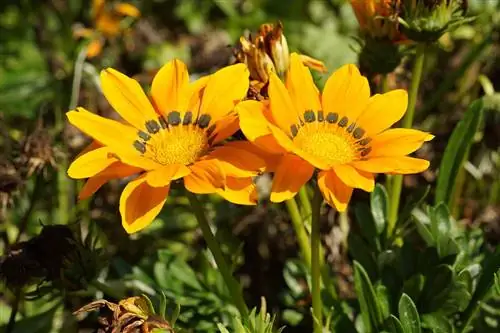
Diseases
TheMildew is one of the most common fungal diseases of our native plants, but is much less dangerous than most other variants. Mildew can be recognized externally by the whitish coating that can be found on the leaves. Either a mixture of milk and baking powder in a ratio of 1:8 or a specific fungicide can be used for treatment.
Pests
Various pests can also cause problems for the gazania. But if you recognize the danger, you can fight it successfully.
Aphids and mites
Infestation by aphids or mites can mainly be observed in plants that are transplanted to an unsuitable location and therefore have a lower ability to protect themselves against pests. Even if the animals themselves are difficult to see with the human eye, the effects of inadequate treatment are often fatal.
While the aphids attack the leaves and take the vital plant sap from them so that they dry out, a mite infestation is characterized by spider-like webs that cover the entire plant.
If the infestation is not yet too advanced, you should consider using the following variants before using an insecticide, as these have proven to be very environmentally friendly and effective at the same time.
- Cleaning the perennial with a powerful jet of water
- Spraying the plants with soapy water
- Spraying the plants with a mixture of milk and water (ratio 1:8)
Snails
The midday gold is one of the favorite foods of snails. In particular, the specimens transplanted in the bed are easy prey for the reptiles. By eating the leaves, the plants become bare and consequently die. By spreading snail pellets, the snails stop eating, so that they spare your plants. It is therefore necessary to distribute the product around the beds at an early stage and to add it at regular intervals. It is also advisable not to keep the soil too moist, as this encourages snail infestation.
Tip:
Sick plants that do not recover despite treatment should not be disposed of in the compost. Since the pests persist even after the plant dies, they infect other plants when the compost is spread.


